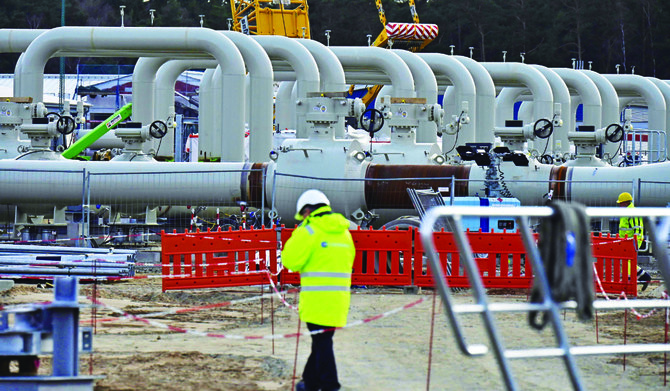Maria Maalouf
At the end of this year, an agreement that allows Russia to sell gas to Europe and deliver it via Ukraine will expire, since it was signed in 2019 for a term of five years.
There has been a great deal of political speculation about whether, given the war between Russia and Ukraine, such a critical economic and political accord will be renewed or not. It would certainly be to the advantage of the three parties to the deal to renew it because each stands to gain from it economically, politically, and strategically.
In essence, this gas agreement is Russia’s only economic pact with Europe, now and for the near future. Ukraine has rejected any prospect of extending the agreement. Russia has confirmed several times that no negotiations are taking place to renew the deal. This precarious situation raises questions about a final economic boycott of Russian gas and oil by Europe.
Currently, and despite the sanctions imposed on Moscow as a result of the war in Ukraine, Russia still exports about 14 billion cubic meters of gas to Europe each year. One delivery mechanism for this is the TurkStream pipeline, which extends through its Balkan Stream pipeline under the waters of the Black Sea and delivers gas from Turkey to Bulgaria, Serbia, and Hungary. A second pipeline runs through Ukraine to Slovakia.
The biggest European countries that are still buying Russian gas are Slovakia, Hungary, Austria, and Italy. The price of Russian gas is slightly lower than supplies from other countries, so they have continued to buy it to save on energy spending. However, all of these countries have signed up to the REPowerEU plan, an agreement that aims to end Europe’s heavy reliance on Russian gas by 2027.
Russia will lose a great deal of revenue if its deliveries of gas via Ukraine are cut off. Such deliveries are managed by Gazprom, the Russian government’s state-owned gas and oil company, which can threaten European clients with financial penalties because most contracts run through 2040.
According to Gazprom’s Chief Financial Officer Famil Sadygov, gas revenues in 2023 from domestic and foreign markets stood at about $48 billion. If Gazprom loses between $7 billion and $8 billion a year in export revenues for the 14 billion cubic meters of gas that goes to Europe, it would be a substantial financial blow.
The technical aspects of transporting gas through Ukraine are significant. For example, one of the benefits to Russia is that European companies pay for the gas they receive through Gazprombank, a Russian financial institution that remains immune from Western sanctions.
On the other hand, Russian pipelines cross the border and pass through Ukrainian metering stations that send the gas on to the European recipients. Ukraine can easily close these stations and shut off the pipeline. However, Kyiv might need to continue transferring Russian gas through its territory. The war with Russia will eventually end. Ukraine can establish a Russian economic dependency on her because its land is where Russia needs to earn hard currency.
Ukrainian authorities might also be hesitant about blocking the flow of Russian gas through their territory because Moscow might retaliate by escalating its war in the country as punishment for Ukraine taking action that hurts the Russian economy.
Russia could also increase the pressure on the West by attempting to broker agreements among the OPEC+ group of oil-producing nations that are harmful to the industrial economies of the US, Canada, and Europe. If OPEC+ lowers oil production levels, for example, prices will go up, which could trigger a recession in Western economies.
The best strategic option for Ukraine is not to let its massive gas supply infrastructure sit idle. The rebuilding of the country when the war ends will increase its energy demands. Ukraine might want to boycott Russian gas deliveries but the reality is that the price of that gas is lower than that of European gas. Therefore, Kyiv will have a financial decision to make.
Ukraine might even be forced to buy Russian gas itself, if the political circumstances force it to do so. There are no European or US plans to explore for oil in Ukraine. Even if they do and find oil and gas quickly in the country, it would take a long time for them to be marketable. Most of the oil refineries and gas depots in Ukraine have been destroyed by Russia during the war.
US President Joe Biden has not commented on this matter. Robert Fico, the prime minister of Slovakia, has suggested that European oil and gas companies, and not Ukraine, could sign their own gas deals with Gazprom. Ukraine’s role in this case would be as a mere conduit, allowing gas to flow through its territory en route to its final destinations in a few European countries. Therefore, any potential gas agreement of this nature would be between Europe and Russia, not between Russia and Ukraine.
Another option is that Europe might try to buy gas from Russia, delivered via Ukraine, but in smaller quantities.
Ukraine will lose $800 million in transmission payments if the gas deal is not renewed. Meanwhile, there might still be demand in Europe for Russian oil. European nations are not united on how best to deal with Moscow.
Perhaps a small country, such as Slovakia, could be successful in ensuring good economic relations between Russia, Ukraine, and Europe by continuing the supply of gas from Russia to Europe despite the war.







